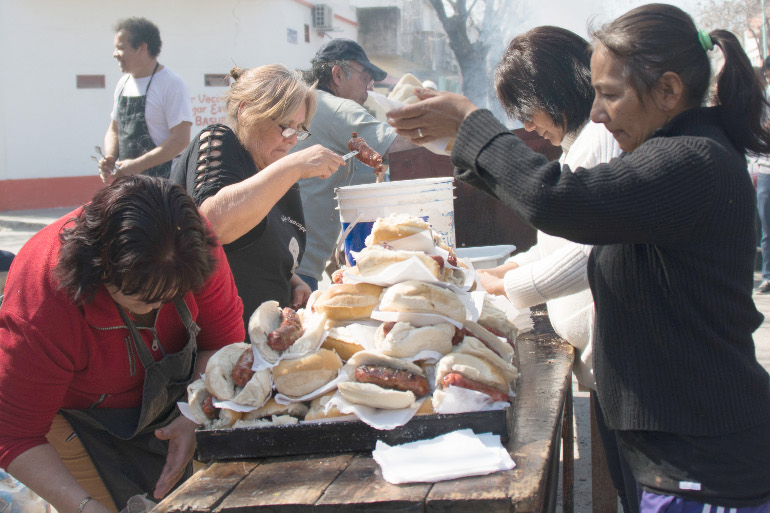
Residents of Villa 21 share choripanes, a traditional chorizo sandwich, following a Mass Sept. 5. (Horacio "Tati" di Renzi)
One of Jorge Mario Bergoglio's legacies began in 2010, when he and Msgr. Victor Fernández, rector of the Catholic University of Argentina, began the initiative Social Commitment and Extension*, where hundreds of college students get involved in social issues affecting las villas. Both students and professors' work includes such activities as teaching health courses, offering therapy, hosting educational day care, and giving entrepreneurial workshops.
"The focus was for the students to leave the university's four walls and get away from their desks to get face-to-face with certain suffering," Hermida said.
While the initiative's primary aim is to broaden the students' understanding of harsh realities in the slums, as well as to humanize poverty, Hermida said one of the most eye-opening observations the group walks away with is noticing how people in the slums don't focus on petty worries.
"They live their life day-to-day with contentment, without our kind of concerns. I see that as a virtue. We stress out about things that keep us from looking around, or from having two-minute conversations. There's a fault in being so rushed that you're unable to see the real issues."
Those in the slums, however, are inclined to look at these academic outsiders with suspicion, a challenge that Hermida said he embraces, believing it is an opportunity for society to act on the obligation of reaching out to those on the peripheries.
Part One: Buenos Aires slums have shaped a papacy
Part Two: Francis' participation with families an example for other priests
Those in academia have a strong social debt to repay, Hermida said, because the privileged tend to stereotype this other world, unaware that they're selective about whom they consider robbers or murderers. Hermida pointed at the country's politicians who steal from its citizens, yet never face consequences.
"Just imagine how when a young boy goes out and steals, it could be what ultimately destroys his family. When drugs begin to run through the streets, a family might be unable to turn in the dealers because one of their kids could get killed — and you see how complicated it all is. These are the points that we need to recognize as a society, and not just by visiting shantytowns, but also by lowering our accusing fingers that create the 'them-us, us-them' dichotomy."
About 10 years ago, Bergoglio, with Padre Pepe, opened multiple casas de oficio — or trade schools — for those 13 years and older, where they are introduced to both practical and creative skills, such as ceramics, computers, baking or mechanics.
Padre Pepe is working toward implementing this project at his current villa. He said the goal is so that even the child of a carton-picker — those who collect and repurpose cardboard they find on the streets — can still grow up with useful skills.
"That's just as important as starting prayer groups," he said. "It's the kind of work where the social and religious meet. There's no need to announce, 'Now we'll begin our hour of prayer, followed by an hour of activity.' No one notices a difference. You can be cooking in the dining room and then go straight to Mass, and to them, it's all the same."
Post-Francis
Just four months before Bergoglio's ascent to the papacy, Villa 21 had already lost their friend and pastor Padre Pepe through his reassignment. One was missed for being on the other side of town yet cautioned not to visit. The other, however, was celebrated as the 266th pope, now with a new identity: from Padre Jorge to el Papa Francisco.
The neighborhood wept and cheered, watching on television as their former archbishop emerged on the balcony, Cabral said. The streets resembled a World Cup victory.
After Francis became pope, worldwide curiosity began to spread regarding his previous life in las villas. Even President Cristina Fernández de Kirchner — a firm public adversary of Bergoglio's throughout his career in Buenos Aires — had previously never visited a villa in her four years as first lady and six years as president. Since his election, she's made several appearances, and even chose a prominent national celebration to be held at Virgin of Caacupé Parish.
"We used to be unknown, and now there's all this attention," Congo said. "Many people started to check out this neighborhood, and they couldn't believe that he'd walk around here by himself, through the alleyways."
Just as Bergoglio's humility as bishop inspired a sense of dignity among the residents, so did the reactions from inquiring reporters who came from across the world to shed light on his background.
The influx of outsiders intimidated the children, who anticipated discrimination, Cabral said. But instead they grew proud, as lines formed of people wanting to hear stories about the new pope.
"It was emotional, because you could see them not feel like they were lesser than other people," she said.
Parish life in Villa 21 blossomed as well, as attendance for both spiritual groups and retreats grew. Everyone was curious to learn what Francis had to say when he was here, Congo said.
Padre Pepe, however, said that priests and missionaries should be careful not to rely on Francis to do all the work. There was a sudden and powerful spiritual whirl that came with this excitement, he acknowledged, and local churches are benefitting from it. But he said that this still shouldn't change what he's always preached: Change comes from the bottom up.
"If Argentines don't seize this moment, it is because we are the biggest fools in the world for wasting this spiritual awakening he brought to our churches. But if we do not change from the bottom, we will not change anything," he said. "People always want magic. They think, 'If the pope does this, then people will come closer to the church.' But people will approach the church when the parish doors are open, when we provoke action from inside the neighborhoods — be it in the slums or not."
Call for change
When Bergoglio named Padre Pepe pastor of the Virgin of Caacupé Parish in 1997, the priest thought to appeal to his Paraguayan base by incorporating a replica of the Virgin of Caacupé, whom Paraguayans revere. At the cathedral, Bergoglio celebrated a Mass welcoming the arrival of this new statue to la villa. After Mass, the crowds exited the church in a huge procession, trailed by their archbishop — a sight his Paraguayan friends hold on to fondly, Congo said.
"The Virgin was like an umbrella for Paraguayans, bringing them together," Padre Pepe said, recalling that ceremony. "But in this villa [La Cárcova], there's not really an element like that, so you have to find a way to unite them. People are coming to the church, but there was a lot of abandonment, and now they're missing a Catholic formation."
Though there are many practicing Catholics where he works now, there are many who left the church and need to be sought out, but carefully. If you forsake people for a long time, he said, then you can't expect them to attend Mass or offer a confession overnight.
To carry out the level of outreach he thinks is necessary, Padre Pepe said, "we must become aware about the need to change many things in the church — which is not the same thing as starting a revolution."
Going from a pyramidal church to a horizontal one, he said, is a crucial change.
When he was pastor at Santiago del Estero in Buenos Aires, he saw that the people were uneasy about having lay lectors and eucharistic ministers. But overseeing 16 chapels, all 30 miles apart from each other, made it impossible for Padre Pepe to preside over the Masses himself. With a more horizontal structure, Padre Pepe said, people could learn to feel more comfortable about one parishioner opening the chapel doors, another doing the reading, and another sharing the Eucharist — the pastor being the organizer.
Padre Pepe oversees nine chapels — none of which were open as he was being interviewed, he said, because parishioners tell themselves, "If Padre Pepe isn't here, we can't go." The diocese must ensure that the chapels are always open, with parishioners working with their pastor on adopting a new structure, he said, adding that laypeople would have special training before assuming such tasks. This, he said, would be vital for church life to flourish.
"It is fundamental that the bishops not take any longer to realize this. This isn't an ideological shift. … We need to reform our ecclesiastical structure, no doubt; it's a methodological change, or ideological only in the sense that the priest is no longer the one who solves everything in the chapel or beholds all the wisdom."
Stronger sacramental outreach, Padre Pepe said, is also imperative for welcoming back those who once strayed. People in the slums, for example, usually don't marry and instead remain as couples raising a family — a fact Padre Pepe said is the church's fault for sending unclear messages.
"Sometimes what holds us back are inutile practices, like denying Communion to the unmarried. And, honestly, that is living in another time, because we are excluding a ton of people who need to receive the Eucharist to truly feel like a part of the church. We must remember that these are people who typically never had catechesis — not the people who were fully formed by their parish. Most people don't have that education, so unfortunately, we are making demands that cannot be met."
Though marriages are declining, Padre Pepe noted that baptisms remain as steady as ever, a fact made clear at that day's 11 a.m. Mass, bookended by baptisms at the chapel of Our Lady of the Miracle.
As the congregation sang the closing song, "Alma Misionera" ("Missionary Soul") the lyrics that concluded the Mass echoed Francis' repeated calls to reach the peripheries, the marginalized, the forgotten:
Take me where man needs your word, where they need your will to live;
Where there is no hope, where there is no joy, simply for not knowing you.
[Soli Salgado is an NCR Bertelsen intern. Her email address is ssalgado@ncronline.org. Follow her on Twitter @soli_salgado.]
Editor's Note: This is Part Three of a three-part series on the Buenos Aires, Argentina, slums and the families who live there.
*An earlier version of this story had an incorrect translation.
